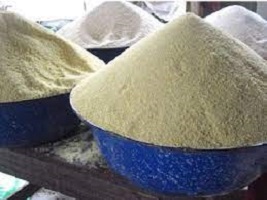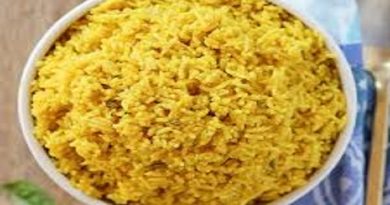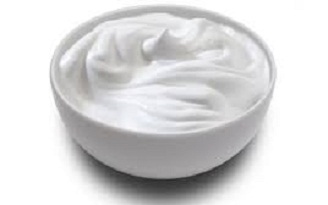How to Make Gari (Eba) – A Staple Nigerian Food Fufu
How to Make Gari (Eba) – A Staple Nigerian Food Fufu. Please watch >>>>
It is one of the most common swallow foods in Nigeria—an essential category of meals traditionally paired with rich, flavorful soups.
What is Gari (Eba)?

Eba is a dough-like swallow prepared by stirring gari into boiling water until it thickens and becomes elastic.
Although simple, it is deeply rooted in Nigerian culinary culture and commonly served alongside soups and stews.
Notably, eba is not eaten on its own. Instead, it is paired with a variety of savory Nigerian soups such as:
- Ogbono Soup
- Banga Soup
- Okro Soup
- Jute Leaves Soup (Ewedu)
- Peanut Soup
- Egusi Soup
- Spinach Stew (Efo Riro)
These soups are typically enriched with proteins like beef, chicken, turkey, goat meat, or fish, making the meal hearty and nourishing.
Why Eba is Special
In addition to its affordability and quick preparation, eba is:
- Gluten-free
- Rich in carbohydrates and fiber
- Mildly sour and sweet in flavor, which complements savory soups perfectly
Where Gari Comes From
The star ingredient—garri—is a granulated flour made from cassava, a drought-tolerant root vegetable that thrives in tropical regions like Nigeria. The cassava is:
- Peeled
- Grated
- Fermented
- Fried or roasted
This process produces dry, shelf-stable flakes that can be stored for months and used in a variety of ways.
Three Enjoyable Ways to Eat Gari Fufu
- Chew It as a Snack
Surprisingly, you can eat garri straight from the pack! Since it’s already roasted, it’s safe to chew.
Try it with groundnuts (peanuts), coconut, or palm nuts for a crunchy, satisfying snack.
- Drink It like Cereal
Another common way to enjoy garri is to mix it with cold water, sugar, milk, and groundnuts. It becomes a refreshing and energy-boosting drink, especially on a hot day.
- Make It into Eba (Swallow)
Finally, and most traditionally, you can turn garri into eba by stirring it into boiling water.
Shape the resulting dough into small lumps, dip into your favorite Nigerian soup, and swallow. It’s simple, delicious, and deeply satisfying.

Let’s Talk About Swallow Foods – Okele
In Nigerian cuisine, swallow foods—locally known as Okele—hold a special place at the table.
These are solid, dough-like meals made from starchy roots, cereals, grains, and even vegetables, traditionally paired with rich soups and stews.
Rather than being chewed, swallows are molded by hand and swallowed whole, making them both filling and easy to digest.
What Are Swallows?
Swallows are a category of soft, cooked doughs prepared from ingredients like cassava, yam, plantain, cocoyam, millet, and flour blends.
They serve as a starchy base for soups in many West African cultures.
Popular Nigerian examples include:
- Fufu (cassava-based)
- Amala (yam flour or plantain flour)
- Pounded Yam
- Eba (made from garri)
- Tuwo (corn or rice-based swallow)
Eba fufu: One of the Most Popular Swallows
Among all swallows, eba stands out as a favorite across Nigeria.
Made by mixing garri (dried cassava meal) with boiling water, eba comes together quickly and is extremely versatile.
You can think of it as the Nigerian equivalent of polenta, though firmer and stickier due to less liquid being used.
Its slightly sweet and tangy flavor, combined with a pliable, sticky texture, makes it the perfect companion for Nigerian soups like egusi, ogbono, okra, banga, and ewedu.
Eba is usually unseasoned—except in special versions like Imoyo Eba, where garri is mixed with flavorful meat or seafood stock, often during Easter celebrations.
Understanding Garri (Gari)
Garri, also spelled gari, is the foundation of eba. It’s a pre-cooked, fermented cassava meal that’s popular throughout West Africa.
It’s different from cassava flour or tapioca starch in both processing and use.
To Produce Gari:
- Cassava tubers are washed, peeled, and grated.
- The grated pulp is bagged and fermented for a few days.
- After fermentation, the moist pulp is roasted or dry-fried—sometimes with red palm oil, which gives yellow garri its color.
- The final product is dry, grainy, and shelf-stable, available in fine or coarse textures.
The duration of fermentation determines garri’s final taste—short fermentation results in a mildly sweet garri, while longer fermentation yields a more sour, less starchy version.
The Many Uses of Garri
Garri isn’t just for making eba. It’s incredibly versatile and used in several other ways:
- Topping for stewed beans, much like Brazil’s farofa
- Coating for frying or baking
- “Soaking garri”, eaten like cereal with water, milk, sugar, coconut, or groundnuts
- Ingredients in casseroles or snacks
Eba Recipe
Preparing gari fufu is simple and fast:
- Boil water and pour it into a bowl.
- Gradually add garri, letting it absorb the water.
- Stir until it forms a cohesive, smooth, and slightly sticky dough.
- Shape into mounds, rolls, quenelles, or decorative designs like hearts and spirals.
Modern presentations of eba can be both creative and elegant, perfect for parties or festive gatherings.
How to Eat and Swallow Foods
Traditionally, you pinch off a small portion of eba or another swallow, roughly the size of gnocchi.
Then, you dip it into your soup or stew, letting it soak up the rich flavors before swallowing. It’s a hands-on, satisfying way to eat that connects deeply with Nigerian food culture.
How to Serve and Eat EbaFufuu (Garri Swallow)
Eba, a staple in Nigerian cuisine, is not only easy to prepare but also fun to shape and serve in creative ways.
Whether you’re a traditionalist or love to play with presentation, eba adapts beautifully to your culinary style.
How to Serve Eba
To serve eba, simply scoop out the desired portion and mold it into a smooth roll using your hands or a plastic wrap.
This is the classic and most common presentation. However, modern Nigerian chefs and home cooks are giving eba a makeover! You can now find eba shaped like:
- Croissants
- Pinwheels
- Pyramids
- Hearts
- Rosettes and layered stacks
These creative shapes don’t change the taste but elevate the presentation, especially useful for special occasions or social media-worthy meals.
How to Eat Eb, a Nigerian food
Eating eba is an experience of its own. Like other swallow foods, eba is cut into small, edible morsels, then dipped into a flavorful Nigerian soup or stew.
With each scoop, you soak up the rich, spicy broth—no need to chew, just swallow and enjoy the sweet, comforting glide down your throat.

Eba FAQs
How much garri to water do I need?
The ideal garri-to-water ratio depends on your desired texture and the type of garri. Some garri types absorb more water due to processing methods.
For beginners:
👉 Start with ½ cup garri to 1 cup boiling water per serving.
- Too soft? Add more garri.
- Too stiff? Add a splash of water and stir well.
You can always double the recipe for larger portions.
Can I eat eba by itself?
No, eba is not meant to be eaten alone. It must be paired with hearty Nigerian soups such as:
- Ogbono soup
- Banga soup
- Okro soup
- Ewedu (Jute Leaves Soup)
- Egusi soup
- Peanut soup
- Efo Riro (Spinach stew)
These combinations create a balanced, delicious, and satisfying meal.
Are eba and garri the same?
No, they are not the same. Garri is the dry, granulated product made from fermented and roasted cassava.
It can be eaten as-is (like cereal) or soaked in water. Eba, on the other hand, is made from garri and hot water, transformed into a swallow.
So think of garri as the ingredient and eba as the final dish.
Why is eba different in color?
Eba can be white or yellow, depending on the type of garri used:
- White eba comes from white garri.
- Yellow eba is made from yellow garri (usually processed with red palm oil).
Both are delicious and completely interchangeable depending on your taste or mood.
Are fufu and eba the same?
No, they’re different. Although both are made from cassava, their preparation and texture vary:
- Fufu is smoother and silkier, usually made by pounding or fermenting cassava.
- Eba has a grainier texture due to the roasted garri granules.
They may look alike, but they have distinct tastes and feel in the mouth.
Make-Ahead & Storage Tips
Eba is best served warm or hot, but it can also be enjoyed cold by some. To store or make ahead:
- Wrap in plastic wrap to retain moisture.
- Mold into a circle or roll.
- Keep in an insulated container to stay warm.
- Reheat in the microwave when ready to eat.
- Unwrap and serve with your favorite soup or stew.
How to Make Eba: 3 Easy Methods
- Stovetop Method
- Boil water in a small saucepan.
- Reduce the heat and gradually add garri while stirring with a wooden spatula.
- Stir until it forms your desired consistency.
- Adjust by adding more garri (if too soft) or a splash of water (if too hard).
- Mold and serve with soup.
- Bowl Method
- Boil water in a kettle.
- Pour into a heat-safe bowl.
- Sprinkle in garri evenly, allowing it to soak.
- Use a spoon or spatula to turn and mix.
- Adjust consistency, mold, and serve.
- Microwave Method
- In a microwave-safe bowl, combine garri and room-temperature water.
- Microwave on high for 5–10 minutes until it comes together.
- Remove and stir until smooth.
- Mold and serve with soup or stew.
More Swallow Dishes You Should Try
Explore other traditional Nigerian soups:
- Pounded Yam
- Fufu (Cassava or Plantain)
- Sadza or Ugali (popular in Southern Africa)
Notes on Ingredients and Variations
Where to Buy Garri
Garri is widely available at:
- Nigerian and West African grocery stores
- Online shops like Mychopchop and OsiAfrik
You’ll commonly find these varieties:
- Yellow Garri – processed with palm oil, slightly richer in flavor
- White Garri – neutral and versatile
- Ijebu Garri – more fermented, crunchy, and sour; ideal for “soaking” (eaten like cereal)
All types of garri can be used to make eba, but the flavor and consistency may differ slightly due to processing variations.
Tips for Perfect Eba Dough
Getting the right texture takes practice. Here’s how to troubleshoot:
- Too soft or watery? Add more garri, 1 tablespoon (15g) at a time, and stir well.
- Too stiff or dry? Stir in boiling water, 1 tablespoon (15ml) at a time, until you reach your desired consistency.
The fermentation level, grain size, and oil content in your garri can all affect how much water it absorbs—adjust accordingly.
Make-Ahead & Storage Tips
While eba is best served fresh, you can prepare it a bit ahead of time if needed:
- After stirring the dough, divide it into portions.
- Wrap each mound tightly in plastic wrap and shape it into a neat round or roll.
- Store in an insulated container to keep warm for up to 2 hours.
- Unwrap and serve when ready.
Avoid refrigerating unless necessary, as reheating eba may alter its texture.
Nutrition Information (Per Serving)
| Nutrient | Amount |
| Calories | 164.8 kcal |
| Carbohydrates | 39.2 g |
| Protein | 1.4 g |
| Fat | 0.3 g |
| Saturated Fat | 0.1 g |
| Polyunsaturated Fat | 0.1 g |
| Monounsaturated Fat | 0.1 g |
| Sodium | 26.3 mg |
| Potassium | 279.1 mg |
| Fiber | 1.9 g |
| Sugar | 1.8 g |
| Vitamin A | 13.4 IU |
| Vitamin C | 21.2 mg |
| Calcium | 23.6 mg |
| Iron | 0.3 mg |
Note: Nutrition values may vary slightly depending on the type of garri used and any added ingredients (e.g., palm oil or soup accompaniments).



Pingback: Eba Meaning Explained: What is Eba? - 9jafoods